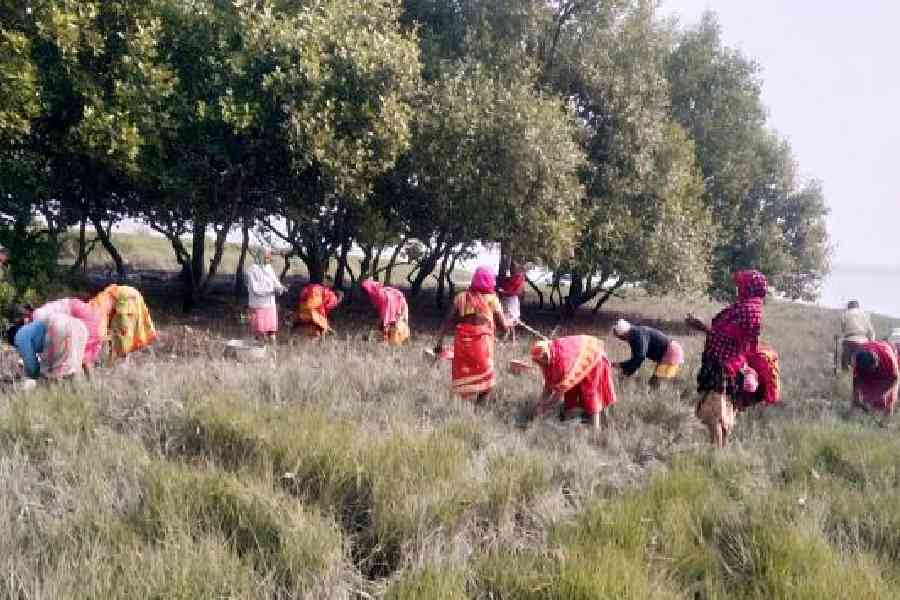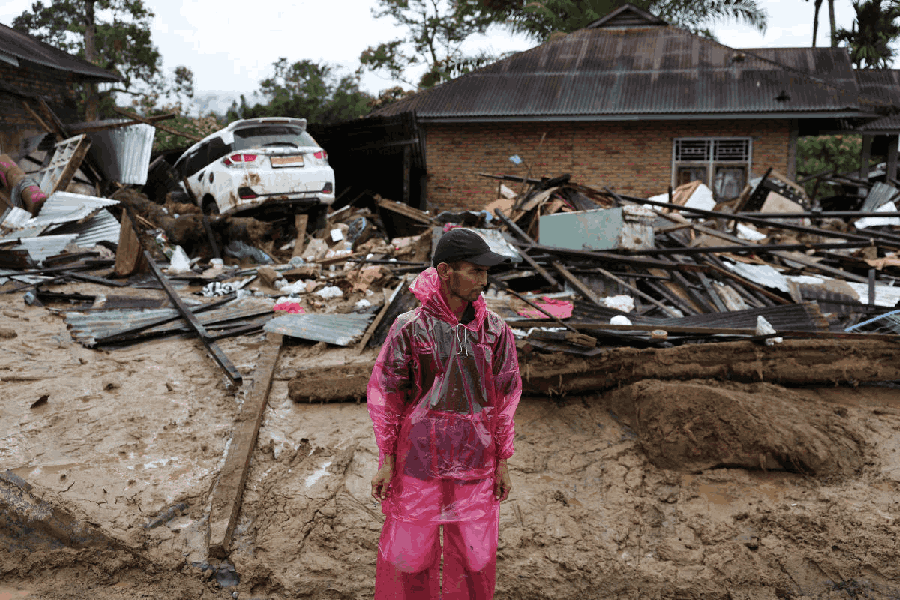Chief minister Mamata Banerjee during the Kalimpong-Darjeeling administrative review meeting on Wednesday proposed planting mangroves and vetiver grass as a natural shield against floods and catastrophic landslides in the calamity-hit region of north Bengal.
However, multiple experts that The Telegraph spoke to since the chief minister's proposal ruled out the feasibility of mangroves, given the topography of the hills and the Terai.
They endorsed vetiver as a doable option, but one pointed out that the efficacy of the grass in erosion control had not been tested in the hills.
Speaking in the backdrop of the heavy rain that triggered flooding and landslides on October 5 that led to loss of at least 33 lives, as well as properties, livestock and infrastructure in the Darjeeling hills and several areas in Alipurduar, Jalpaiguri and Cooch Behar, Mamata underscored that her government intended to explore “natural options” to mitigate damage caused by floods and landslides.
“Nature can protect nature.... The state forest department should take up the task to plant mangroves and vetiver grass across north Bengal to curb floods and landslides. They should remove boulders and stones and carry out the plantation for the next three months,” she said, directing officials of the forest and irrigation departments to explore the idea, citing the success of mangrove plantations in the Sundarbans and on Sagar Island.
“Start planting mangroves and vetiver. These are stronger than concrete, which often collapses within six months. I am not interested in investing money and draining (it like) water,” Mamata said.
The Telegraph reached out to experts to assess whether mangrove plantations could serve as flood barriers or bio-shields in north Bengal.
Mangroves are shrubs or small trees that thrive in saline or brackish coastal waters. Their dense root networks filter pollutants and prevent erosion by stabilising the soil. Species such as Kalo Bain (Avicennia alba), Peyara Bain (Avicennia marina), Hargoja (Acanthus ilicifolius), Kewra (Pandanus), Geoan (Excoecaria agallocha), Garan (Ceriops decandra), and Sundari (Heritiera fomes) dominate the Sundarbans ecosystem.
Agriculturists welcomed Mamata’s environmental concern but unanimously agreed that the idea of planting mangroves in the hills was scientifically untenable.
Debolina Sarkar Bhattacharya, assistant professor in agri-geo informatics at Neotia University and a senior research fellow with the CSIR, said: “Mangroves are a special type of salt-tolerant trees that grow only in warm and subtropical coastal areas where freshwater mixes with seawater. Cold climate, freshwater sources and rocky terrain are not at all conducive to mangroves.”
Bhattacharya added: “Even if we plant mangrove saplings in the hills, they will not survive. These trees cannot tolerate cold or snowy conditions and require brackish water, which is found only in coastal areas.”
“Mangroves thrive in tidal, low-lying coastal zones where the rhythm of high and low tides sustains them—conditions entirely absent in the hills,” she added.
Jatiswar Bharati, an academic based in Jalpaiguri, spoke in a similar vein. “Plantation is one of the ways by which we can get long-term results (to control floods and landslides). But mangroves are not a suitable species for north Bengal,” Bharati, the assistant general secretary of Bangiya Bhugol Mancha, said.
Monoranjan Das, a retired botany teacher in Malda, said: “Mangroves grow in clay soil, while the soil in the hills is rocky and sandy.”
Umashankar Mandal, popularly known as the “Mangrove Man of Sundarbans” for his reforestation initiatives through his platform Purbasha, said: “Planting mangroves on the riverbanks in Darjeeling’s hilly terrain is an impractical idea for scientific reasons. The climate, atmosphere, and soil composition of the hills do not support mangrove species. It’s unclear why such a proposal was made.”
“Pine, spruce, and deodar are naturally adapted to cold and rocky environments to stabilise the soil. Their needle-like leaves and waxy coatings minimize water loss, and their deep roots grip the thin, rocky soil effectively,” Bhattacharya said.
Vetiver fine as option
Experts unanimously endorsed Mamata’s suggestion of vetiver grass (Vetiveria zizanioides), commonly known as “khus ghash”, as a proven bioengineering solution for erosion control.
“Vetiver’s dense root system can grow 3–4m deep, forming a strong mat that anchors soil, prevents erosion and stabilizes steep slopes. Studies show it can reduce soil erosion by over 90 per cent compared to bare slopes,” said Ratikanta Ghosh, a retired professor in agronomy at Bidhan Chandra Krishi Viswavidyalaya.
Ghosh, however, added: “Vetiver’s ability (to check erosion) in hill areas has not been tested as far as I know.”
In March 2015, the Nadia administration launched a ₹33 crore project to plant vetiver grass along riverembankments.
Rivals ridicule CM
Opposition parties ridiculed Mamata’s scientific understanding.BJP leader Suvendu Adhikari in a post on X mocked Mamata’s “lack of basic topographical sense”, saying “mangroves are salt-tolerant species thriving in brackish coastal waters, not in mountainous terrains.” He added that Mamata’s had made Bengal a “laughing stock”.
Senior CPM leader Sujan Chakraborty called the proposal “ridiculous.” He said, “She doesn’t know that growing mangroves in the hills is not feasible, and nobody in her party dares to tell her the scientific truth.”
Minister defends 'dream'
Manas Ranjan Bhunia, minister for irrigation and waterways, whose department — along with the forest department — has been tasked with planting mangroves in the hills and the Terai, defended the chief minister.
“Mangroves can be grown anywhere. Let us experiment. The chief minister has made a proposal with a dream, and we will try to realise it,” Bhunia told The Telegraph.
Additional reporting by Soumya De Sarkar in Malda and our correspondent in Jalpaiguri











